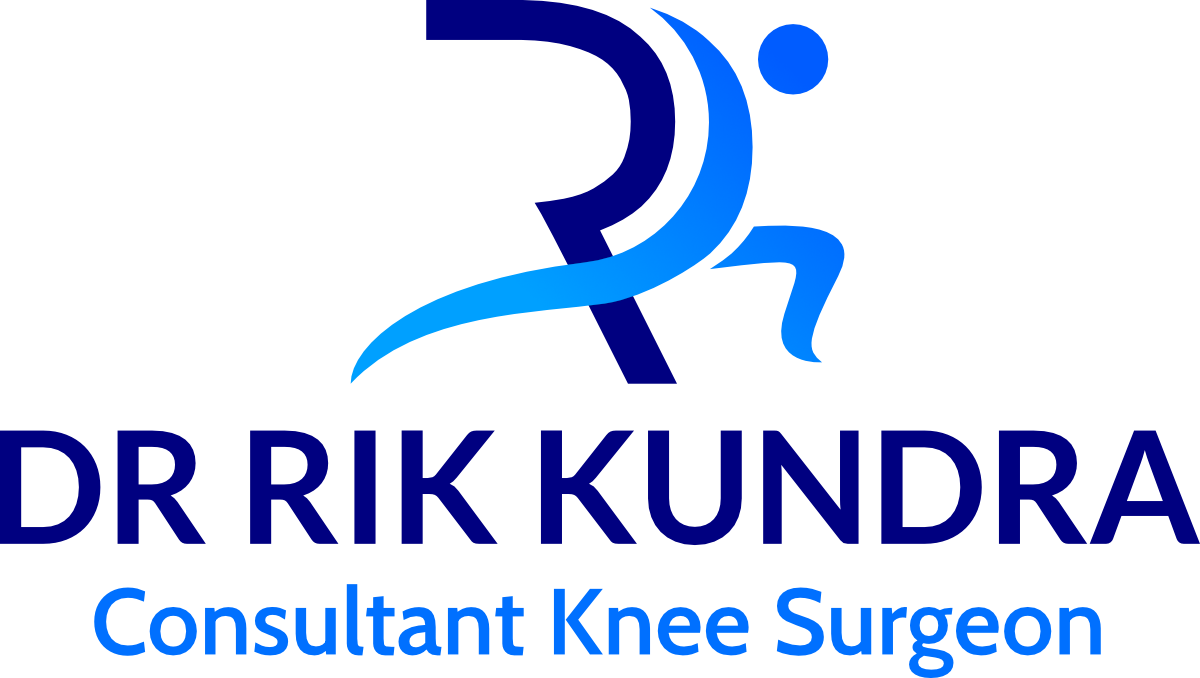What Does a Torn ACL Feel Like?
A torn ACL can turn even the simplest movement into a challenge, whether it’s walking down the stairs, getting up from a chair, or returning to your favorite sport. Many describe it as a sudden “pop” in the knee followed by intense pain, swelling, and an unsettling feeling that the knee might give way.
So, ‘exactly, what does a torn ACL feel like?’
At Dr Rik Kundra’s clinic, we understand that it’s not just a physical setback but an emotional one too, especially for those who lead active lifestyles. So, Dr Rik makes sure that his patients receive advanced, personalized treatment for ACL tears, from precise diagnosis to modern surgical repair and structured rehabilitation, helping them regain stability, confidence, and the freedom to move without pain.
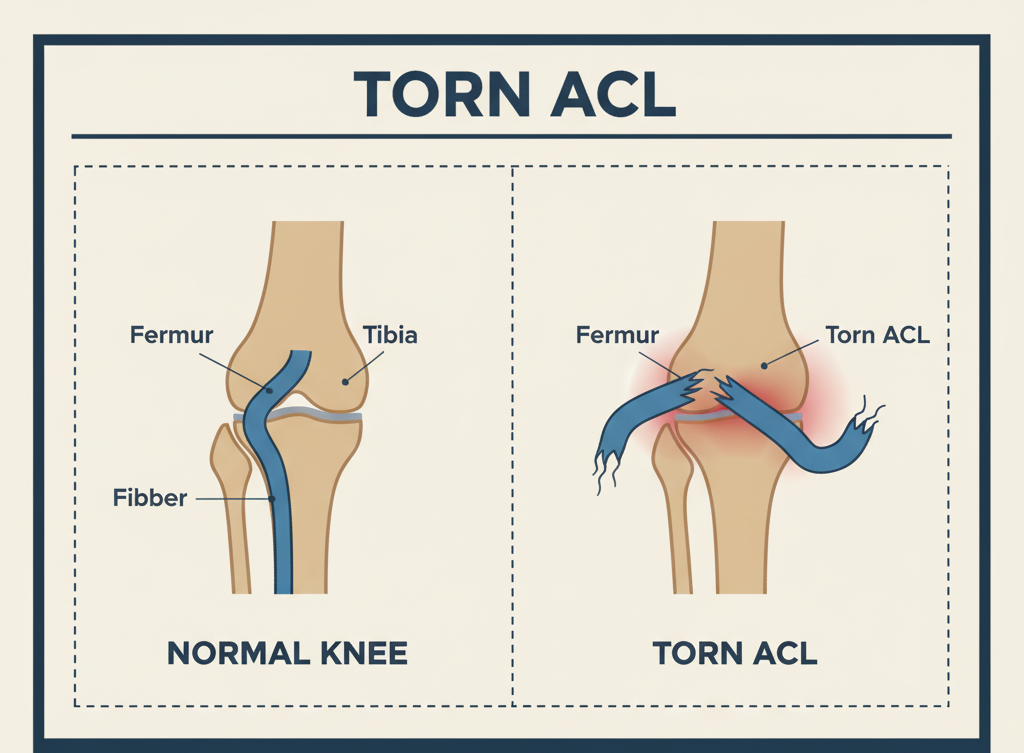
Understanding the ACL
Before understanding what a torn ACL feels like, it helps to know what the ACL actually is. The anterior cruciate ligament (ACL) is one of four major ligaments that keep your knee stable. It connects the thigh bone (femur) to the shin bone (tibia), running diagonally through the center of the knee. Its main job is to prevent the shin bone from sliding too far forward and to provide rotational stability, especially during sudden stops, twists, or directional changes.
When the ACL is stretched beyond its limit, often during sports like football, basketball, skiing, or even an awkward landing, it can partially or completely tear, leading to varying levels of pain and instability.
Where is your ACL located?
To understand the ACL Pain Location, you must understand where your ACL is located. The pain from an ACL tear typically originates from the center or back of the knee and can radiate to the surrounding areas. While the pain intensity varies, most people feel it when trying to straighten or twist the leg. It can also increase when attempting to stand, walk, or climb stairs.
Because the ACL lies deep within the joint, the pain can feel more internal rather than sharp or localized on the surface. Understanding this pattern helps differentiate it from other injuries such as meniscus tears or ligament sprains, something Dr Rik Kundra specializes in identifying through precise examination and imaging.
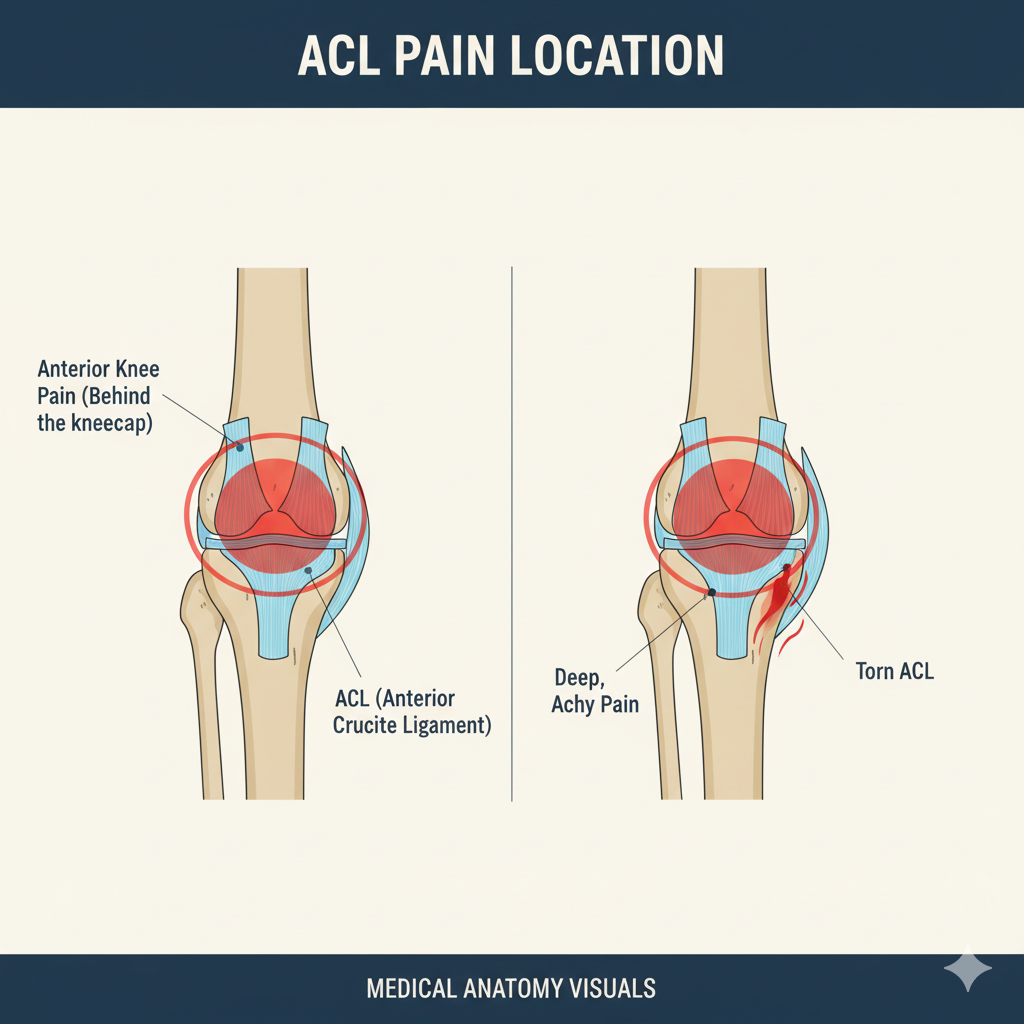
What does a torn ACL feel like?
For many, an ACL tear is described as a distinct, unforgettable moment. You might hear or feel a “pop” in the knee at the time of injury, followed by immediate pain and swelling. Within minutes or hours, the knee can become stiff and tender, making it difficult to walk or bear weight.
Common sensations include:
- A sharp or deep pain immediately after the injury
- Rapid swelling (within a few hours)
- A feeling that the knee is “slipping out” or unstable
- Limited range of motion
Some people report that the pain subsides quickly, leading them to underestimate the severity. However, even when the pain lessens, the instability and loss of strength in the knee persist, clear signs that medical evaluation is essential.
At Dr Rik Kundra’s clinic, a detailed examination combined with imaging such as MRI helps confirm the extent of the ACL injury and guide the most effective treatment plan.
Also Read – Knee popping and pain: Causes and when to consult a doctor
What does a partially torn ACL feel like?
Not every ACL injury is a complete tear. A partially torn ACL can be more subtle and sometimes mistaken for a mild sprain. You might still be able to walk, but your knee could feel slightly unstable or weak, especially during twisting or pivoting movements.
Symptoms of a partial tear often include:
- Mild to moderate pain when bending or rotating the knee
- Swelling that may appear gradually rather than instantly
- A sense of tightness or “catching” inside the knee
- Occasional giving way or loss of balance
Dr Rik Kundra carefully evaluates such cases to determine whether non-surgical management (like physiotherapy and bracing) or surgical reconstruction will deliver the best long-term outcome. The goal is always to restore natural movement while minimizing the risk of future injury.
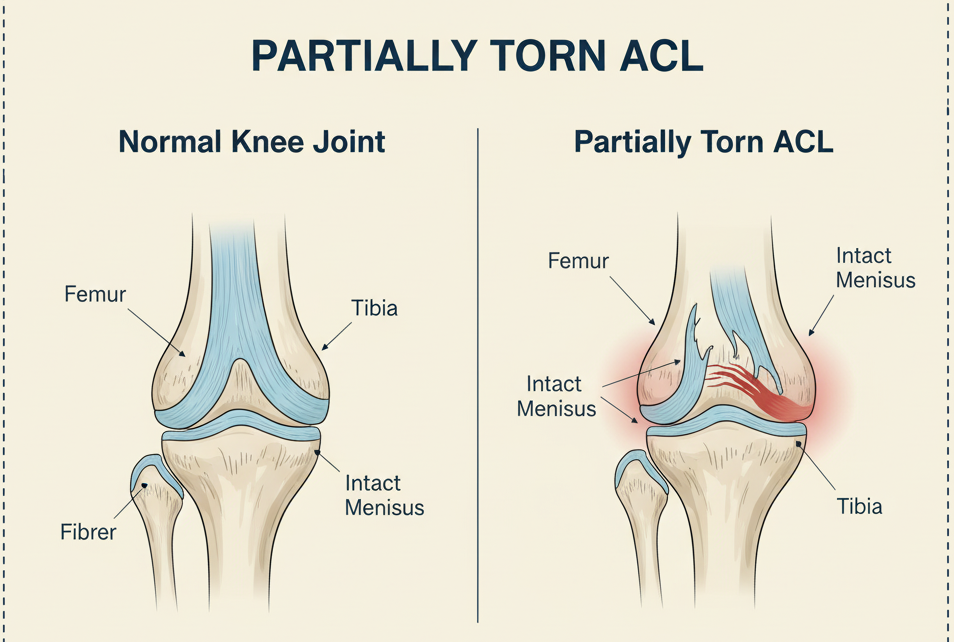
What does a Torn ACL feel like when walking?
Walking with a torn ACL can feel uncertain and unstable. Many people describe it as though their knee is not trustworthy; it might feel wobbly or buckle unexpectedly. In mild cases or partial tears, you may still manage short walks, but the instability often worsens when going up or down stairs, turning, or walking on uneven surfaces.
You might also notice:
- Pain along the inside or front of the knee (the typical ACL pain location)
- Swelling that increases after walking
- A stiff feeling that limits full extension or bending
With Dr Rik Kundra’s expertise, patients receive a structured plan to regain stability. This may include early physiotherapy, guided strengthening exercises, and if needed, minimally invasive ACL reconstruction to restore normal function and confidence in movement.
ACL Tear Swelling: What does it look and feel like?
One of the hallmark signs of an ACL tear is rapid swelling due to internal bleeding within the joint. This swelling can make the knee appear puffy, tight, and warm to the touch. In many cases, the knee may feel so swollen that bending becomes difficult or painful.
(If you’ve seen ACL tear swelling pictures, you’ll notice how the injured knee can look visibly larger compared to the other.)
The swelling usually peaks within the first few hours after injury and may last for several days. Applying ice, elevating the leg, and resting can help reduce discomfort initially, but medical evaluation remains crucial to prevent complications.
Can you walk with a torn ACL?
In many cases, people can walk short distances with a torn ACL, but that doesn’t mean the injury is minor. The surrounding muscles and other ligaments may temporarily compensate, masking the true extent of the damage.
However, without proper treatment, continued walking or physical activity can cause further injury to the knee, especially to the cartilage and meniscus.
That’s why Dr Rik Kundra emphasizes early diagnosis and tailored treatment. For some, bracing and physiotherapy may suffice, while for others, especially athletes or active individuals, ACL reconstruction surgery offers the best chance for full recovery and a safe return to sport.
Treatment for Torn ACL Pain: How Dr Rik Kundra helps you heal and move forward?
Dr Rik Kundra provides both non-surgical and surgical solutions, ensuring every patient receives a personalized plan that prioritizes comfort, healing, and safe return to movement.
Non-Surgical Treatment Options
For patients with a partial ACL tear or less demanding physical activities, non-surgical care may effectively reduce pain and restore knee function.
Rest, Ice, Compression, and Elevation (RICE):Immediately after injury, RICE therapy helps control swelling and relieve pain. Dr Rik often pairs this with anti-inflammatory medication to manage discomfort in the initial phase.
Physiotherapy and Bracing:
A guided physiotherapy program focuses on strengthening the muscles around the knee, particularly the quadriceps and hamstrings, to improve stability and prevent further injury. Custom knee braces may also be recommended to support movement and prevent instability during healing.
Platelet-Rich Plasma (PRP) Therapy:
PRP is a regenerative treatment that uses a patient’s own blood platelets to promote tissue repair. The concentrated plasma, rich in growth factors, is injected directly into the affected area to stimulate healing and reduce inflammation. For partial ACL tears or as part of post-surgical recovery, PRP can accelerate healing and improve joint function.
Stem Cell Therapy:
Stem cell therapy represents a cutting-edge, non-surgical approach for ACL injury management. Stem cells derived from the patient’s own body are injected into the injured area to promote natural tissue regeneration. This therapy can help restore ligament strength, reduce pain, and improve flexibility, making it an excellent choice for patients who want to avoid surgery or enhance recovery after a repair.
Activity Modification:
Dr Rik Kundra also helps patients adapt their daily routines, recommending low-impact activities like swimming or cycling during recovery to maintain fitness without stressing the injured knee.
Surgical Intervention
When the ACL is completely torn, surgical reconstruction is often the most effective way to restore knee stability and prevent long-term complications such as joint degeneration or meniscus injury.
ACL Reconstruction entails replacing the damaged ligament with a graft, often taken from the patient’s hamstring or patellar tendon. Using minimally invasive techniques, Dr Rik Kundra performs this procedure with precision to ensure faster healing, less postoperative pain, and better cosmetic results.
After surgery, a structured rehabilitation program begins immediately. The motive is to restore full range of motion, rebuild muscle strength, and gradually help the patient return to sport or daily activities.
A Holistic Approach to Recovery
Whether through regenerative medicine or advanced surgery, Dr Rik Kundra emphasizes a comprehensive, patient-centered approach. His treatment philosophy combines medical precision with empathetic support, ensuring every patient not only heals physically but also regains confidence in their movement.
By integrating modern therapies such as PRP and Stem Cell treatments with proven surgical and rehabilitation methods, Dr Rik helps patients experience faster recovery, reduced pain, and long-lasting joint stability, paving the way back to an active, pain-free life.
Listening to What Your Knee Is Telling You
A torn ACL can feel like a sudden loss of stability, both physically and emotionally. If you’ve ever wondered what does a torn ACL feel like, it’s often described as a popping sensation followed by pain and instability. But it’s also a treatable condition with an excellent prognosis under the right care. Whether you’re an athlete eager to return to the field or someone simply looking to walk without worry, Dr Rik Kundra offers the expertise and reassurance you need to heal with confidence.
If you suspect an ACL injury, don’t wait. Early diagnosis and expert care make all the difference.
Schedule a consultation for a stronger, pain-free knee and a return to the life you love.
Disclaimer
All content and media on this page are created and published for informational purposes only. It is not intended to be a substitute for professional medical advice and should not be relied on as health or personal advice. Meet Dr. Rik personally for appropriate medical diagnosis and advice.

